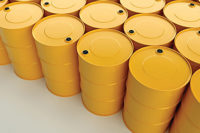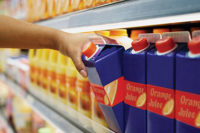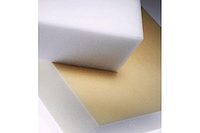Butyl Elastomer Emulsion
Ostensibly, the manufacture of an aqueous dispersion from a bale of butyl rubber does not seem terribly complicated. Dispersion technology is often thought of as brute force overcoming nature. This force (mechanical dispersing) is used to produce an improbable aqueous version of an elastomer that shows no natural hydrophilic propensity. On the surface, it seems an easy yet tedious task to convert a solid polymer such as butyl rubber into an aqueous dispersion.In fact, Lord Corporation is the only provider of Aqualast BL-100 aqueous butyl elastomer emulsions in the world. The process starts with rendering the butyl polymer into a workable cement phase. Surfactants and additional stabilizers are used during the emulsification process; these are carried in the aqueous phase. During emulsification, the raw components are converted to submicron-size, homogeneous raw latex.
The raw latex is stripped and concentrated to provide a stable aqueous emulsion of butyl rubber. The final product, Aqualast BL-100, provides a VOC-free and virtually analogous alternative to solvent-based technology.
Upon arrival to a manufacturing plant, the unformulated elastomer emulsion typically requires various additional ingredients added to it for physical-property enhancement. The uncured, unfilled, dried elastomer emulsion has limited practical utility compared to its formulated version and its solvent analog. The selection and amount of each material added to the emulsion will depend on what physical properties are being sought since each ingredient contributes unique properties. There is no simple way to describe the multitude of materials this can encompass. The next section of this article will detail some formulating work on Aqualast BL-100 butyl elastomer emulsion.
Experimental
Tables 1 and 2 show two different formulations employed to examine property enhancement of formulated products produced with Aqualast BL-100 compared to their unformulated analog. Note, the solid ingredients added to the raw elastomer were added as dispersions.Dry films of the emulsions were made by drawing a wet sample of either the formulated or raw Aqualast BL-100 onto a glass plate maintained at room temperature. Most of the water is allowed to evaporate prior to curing the formulated films. Dry films of the raw, unformulated Aqualast BL-100 were not cured prior to testing. The formulated recipes were cured using a one-hour immersion in boiling water or one hour in an oven maintained at 116ºC.
Mechanical Stability
Aqualast BL-100 butyl emulsion and other Lord elastomer emulsions are often formulated to impart sought-after physical properties. Mechanical stability (ASTM Method D1417-96) is essential for the ease and convenience of pumping and material transfer, where the formulated product may be exposed to conditions of high shear.The following section outlines the general ASTM test method. Aqualast BL-100 butyl emulsion is diluted with deionized water to 350 cps. It is then sheared at 14,000 ± 200 rpm for 30 minutes. Any coagulum formed after this time is a measure of the emulsion’s overall mechanical stability. The results show that there was 0% coagulum observed after 1,800 seconds.
Unaged Tensile Properties
Unaged tensile strength (ASTM Method D412-97) was evaluated on specimens exposing them only to room temperature. Two formulated versions of Aqualast BL-100 were tested alongside the raw product to evaluate/quantify the amount of physical-property enhancement achieved.Dry films of the emulsion are cast using a drawdown technique. Specifically, a wet sample of the emulsion is drawn down on a clean glass plate using a drawdown bar set to produce a dry film of 0.010 to 0.015 inches. The surface layer of the drawn-down emulsion is allowed to dry prior to placing it in an oven set at 50ºC. Samples are then dried in this oven for one hour. Two different cure schemes were utilized for the formulated emulsions.
The schemes included either an exposure to boiling water for one hour or exposure to an oven maintained at 116ºC for one hour. Upon removal from the oven, cured films were removed from the glass. Tensile samples (dumbbells) were cut with a die “C” template. These samples are used to evaluate tensile properties. Dumbbells are pulled at room temperature at a rate of 20 inches per minute. The percent elongation and load required to fail each sample were recorded. The results presented in Table 3 are an average of three samples for each condition tested.
Aged Tensile Properties
For the “aged” tests, dumbbells were conditioned seven days at 70°C prior to testing. The testing procedure (ASTM Method D412-97) is the same as the “unaged” tests (Table 4). Dried Aqualast BL100 did not survive the conditioning. This is intuitively what one would expect without the addition of a curing agent.Tensile Set
Since it is not practical to evaluate compression set on a dried elastomer film due to the tedious nature of the sample preparation required, tensile set was examined instead. Die “C” dumbbells are pulled to failure at 20 inches per minute. After 10 minutes, pieces of the failed samples are placed together at their failure point, and the length of the samples is measured. The new length is recorded and compared to the original length. The percent change in length is recorded. This enables one to quantify the elastomeric change that is not recovered after 10 minutes (Table 5).Note: The lower the values for tensile set, the larger the amount of recovery for the failed film. This physical property is essential when the end-use application requires dimensional stability. In this case, the uncured/raw elastomer emulsion outperformed Recipe #2 when it was oven cured. The reason for this is not altogether clear.
Tear Resistance
This test measures the amount of resistance to tear growth after a sample is notched in a very controlled, specific manner (ASTM Method D624-91). Die “C” dumbbells are pulled at 20 inches per minute after they are notched. This physical property is essential for belting applications where small tears could lead to catastrophic failure. Data is expressed as the amount of force to fail the samples (Table 6).Flexural Fatigue Life
Flexural-fatigue testing in this case does not necessarily follow any specific ASTM test method. Therefore, one was adopted to examine this very important physical property. Die “C” dumbbells are cut and cycled from 0 to 100% elongation. This is accomplished while pulling each sample 300 cycles per minute. An Instron tensile tester programmed to accommodate this type of cyclic testing is employed (Table 7).Oil Resistance
Die “C” dumbbells are immersed in soybean oil (per ASTM D471 and ASTM Method D412) for four hours maintained at 25°C and 70°C, respectively. Upon removal from the oil, samples are measured for volume change and tensile properties (Table 8).Ozone Resistance
Dry film samples are placed in an enclosed chamber for 48 hours exposed to 100-pphm ozone at 40°C (ASTM D-1149 Method B). After the ozone conditioning is complete, samples are examined with an optical microscope at 7x magnification. No cracks were observed in any of the four samples.Water Absorption
Samples are immersed in deionized water at 72ÞC for 24 and 72 hours, respectively (ASTM D-471-96). The percent volume change is measured and recorded. This is an important test for dimensional stability during water immersion (Table 9).Solvent Resistance
A thin-dried film of the elastomer emulsion is placed in an instrument that is capable of sensing the presence of the immersion liquid (toluene) on the opposite side of the film (ASTM F-739). Breakthrough time of solvent penetration and permeation rates are recorded. This is an essential test for barrier properties for specialty clothing where people may be exposed to solvents (Table 10).Note: The uncured raw-elastomer film did not survive the conditioning prior to testing. Solvent resistance in terms of breakthrough time and rate of permeation was greatly enhanced by formulating.
Gas Permeability
This test measures the volume of gas being passed through a sample of elastomer of known thickness for a specified duration (ASTM D1434-92). Data from this test is used for selecting materials with appropriate barrier properties to various gases since the selection of gas tested is the choice of the experimenter. This study used a Custom Scientific Model CS-135 meter. The test gas in this case was air.Specimen cross-sectional area was 66.4 cm2. Test temperature was 23.0ÞC; test pressure was 5.0 psig; and the sample thickness was 0.1166 cm. The capillary diameter was 0.1 cm (Table 11). Resistance to gas permeability can be greatly enhanced as evidenced from the data obtained from the formulated samples.
Summary
With this technology, Lord Corporation stands alone as the sole provider of Aqualast BL100 and many other aqueous elastomer dispersions. These products currently are the only aqueous versions analogous to solvent-carried alternatives. The emulsions are easy to work with since they contain no VOCs, and they clean up well with water. Lord Corporation’s elastomer emulsions are a first step to accommodate the market’s dual needs of keeping the environment green while at the same time refusing to compromise performance.This article was adapted from a presentation given at the International Waterborne, High Solids, and Powder Coating Symposium; Feb. 11, 1999; New Orleans, La. The University of Southern Mississippi, Dept. of Polymer Science, Hattiesburg, Miss., sponsored the symposium.


